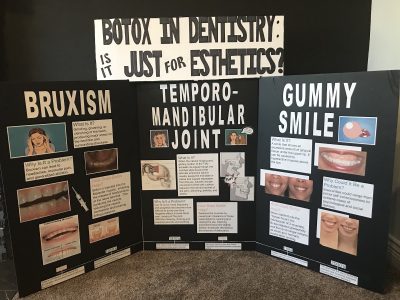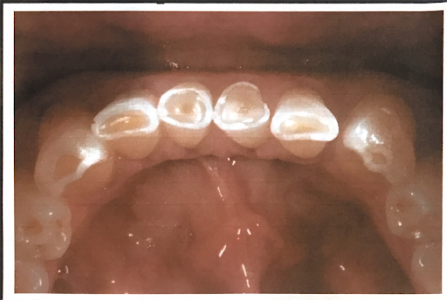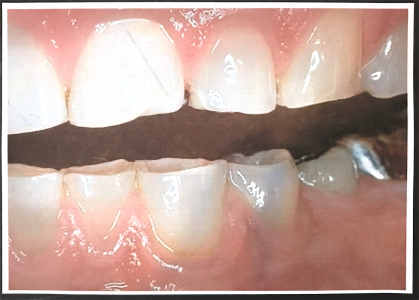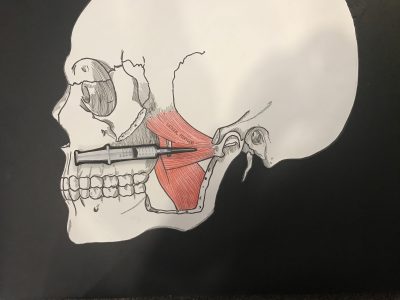BOTOX IN DENTISTRY: IS IT JUST FOR ESTHETICS?
INTRODUCTION
Botulinum Neurotoxin protein is derived from the bacterium Clostridium Botulinum. This bacterium is commonly found in plants, soil, water, and animal intestinal tracts. Its track record would not lead you to believe it would be commonly used in present day healthcare. Its discovery involved a deadly outbreak of botulism due to spoiled pork by a Belgium professor in the late 1800’s. It has since progressed to a licensed FDA approved treatment used for cosmetic and functional purposes. Its uses in dentistry include a therapeutic treatment for bruxism, dislocation of the temporomandibular joint and a gummy smile.

BRUXISM
What is bruxism? Bruxism is a condition in which one habitually grinds, gnashes, or clenches their teeth .
When does it happen? Typically it happens while asleep, due to an abnormal bite, missing or crooked teeth, or by a sleep disorder such as sleep apnea (when breathing repeatedly stops and starts). It can also be the result of stress and anxiety.
Why is it a problem? Bruxism creates major stress on the dentition and surrounding structures, leading to a variety of symptoms such as headaches, muscular pain, and generalized attrition. Generalized attrition (can be seen below) is the loss of tooth structure due to wear caused by tooth to tooth contact, in this case bruxism. This can expose dentin and create sensitivity.
How does Botox help? There are different approaches to fixing bruxism such as wearing a mouth guard, but injecting BTX-A has become a new alternative option that can be a safe and effective remedy. It is an expensive and temporary treatment so it should be considered a therapeutic option for those who have complicated or disabling bruxism that is unmanageable by other medical or dental therapy. Botox is injected into the Masseter Muscle ( shown below on the injection board) which inhibits the release of Acetylcholine at the nerve terminal. Acetylcholine is a neurotransmitter which is a chemical that sends signals across the nerve synapses and binds to the receptors, signaling that it is time to contract the muscles and cause movement . Once inhibited the muscles become paralyzed , reducing muscle contraction and lowering biting pressures up to 20-30%. In conclusion, relief is observed when the cause of muscle contraction is eliminated.





TEMPOROMANDIBULAR JOINT
What is TMD? Temporomandibular Disorder, or dislocation of the temporomandibular joint; is when the natural hinging and gliding motion of the TMJ exceeds its regular range. The condyle slips beyond the articular eminence (which usually keeps the mandible in place), and causes separation from the jaw. Different causes for this syndrome include movement of the soft cushion between the ball and socket of the joint, clenching, arthritis, and stress.
Why is it a problem? The more often dislocation happens, the more likely it will re-occur until it progressively becomes more difficult to avoid over time. This can cause multiple different negative effects that include facial pain, locking of the joint, difficulty chewing, clicking and popping sounds, and swelling.
How does Botox help? BTX-A is injected into the lateral pterygoid muscle in one of two ways: internally (in the oral cavity behind the maxillary tuberosity) or externally. This injection weakens the muscles by causing an imbalance of those responsible for opening and closing the jaw. The opening movement becomes slightly limited, drastically decreasing the chances of further dislocation happening in the near future.


GUMMY SMILE
What is a gummy smile? A gummy smile is a smile that shows an excessive amount of gingival tissue under the upper lip. The main cause of this appearance is due to hyperactive muscles in the lips.
Why is it a problem? This feature may not cause any pain or discomfort; however a patient may seek a corrective treatment due to issues with self consciousness. The insecurities could range from minor self consciousness to extreme cases of psychological and social distress.
How does botox help? In cases where this feature is caused by hyperactive muscles, Botox can be an effective solution. The botox is injected into the Yonsei Point, which is the intersection of 3 muscles: the Levator Labii Superioris Aleue Nasi, Levator Labii Superioris ,and the Zygomaticus Minor. The Yonsei Point is located by finding a point three centimeters above the commissure of the lip, and one centimeter lateral to the nostrils. Botox relaxes the muscle hyperactivity and the lip will no longer retract as much as it normally would when smiling. This makes a significant difference in the appearance of the patient’s smile and boosts their self confidence. 


CONCLUSION
Minimally invasive and reversible, botulinum neurotoxin has the potential to compete with more severe and aggressive procedures in the resolution of multiple different issues in the dental field. It has significant value on the quality of life in patients who may have been unresponsive to other treatments, or who are resistant to undergo them. Its journey from a poisonous substance to a versatile, resourceful, therapeutic agent has—and will continue to do so—broadened the horizons in the treatment of many complications in dentistry.
Archana, M.S. (2016). Toxin yet not toxic; Botulinum toxin in dentistry. The Saudi Dental Journal 28 (2), 63-69 doi.org/10.1016/jsdentj.2015.08.002 Ashenburg, Katherine. “The Real History Behind the Birth of Botox.” Reader’s Digest Canada. Retrieved from https://www.readersdigest.ca/health/beauty/birth-botox/ Accessed 28 February 2020 “Dental Health and Teeth Grinding (Bruxism).” WebMD. Retrieved from https://www.webmd.com/oral-health/guide/teeth-grinding-bruxism#1 Accessed 28 February 2020 Dinker, S., Anitha, A., Sorake, A., Kumar, K. (2014) Management of Gummy Smile with Botulinum Toxin Type-A: A Case Report. Journal of International Oral Health, 6 (1). 111-115 Fu, K., Chen, H., Sun, Z., Zhang, Z., Ma, X. (2010). Long-term Efficacy of Botulinum Toxin Type A for the Treatment of Habitual Dislocation of the Temporomandibular Joint. British Journal of Oral and Facial Maxillofacial Surgery, 48 (4), 281-284 doi.org/10.1016/j.bjoms.2009.07.014 “The History of Botox.” CosmedicsUK. 5 August 2013, Retrieved from https://www.cosmedics.co.uk/the-history-of-botox/ Accessed 28 February 2020 Kwon, K., Shin, K.K., Yeon, S., Kwon, D. (2019). Application of Botulinum Toxin in Maxillofacial Field: Part 1. Bruxism and Square Jaw. Maxillofacial Plastic and Reconstructive Surgery, 41 (38), doin.org/10.1186/s40902-019-0218-0 Lieberman, Bethany. “Acetylcholine: Definition, Function & Deficiency Symptoms.” Study.com. Retrieved from https://study.com/academy/lesson/acetylcholine-definition-function-deficiency-symptoms.html Accessed 27 February 2020 “Sleep Apnea.” Mayo Clinic. 25 July 2018, Retrieved from https://www.mayoclinic.org/diseases-conditions/sleep-apnea/symptoms-causes/syc-20377631 Accessed 28 February 2020 Tan, E.K., MD., Jankovic J., M.D. (2000). Treating Severe Bruxism with Botulinum Toxin. The Journal o American Dental Association, 131 (2), 211-216. doi.org/10.14219/jada.archive.2000.0149 Zeidler, Maryse. “30 years ago, this Vancouver doctor pioneered use of Botox for cosmetic purposes.” Canadian Broadcasting Corporation. 10 December 2017, Retrieved from https://www.cbc.ca/news/canada/british-columbia/30-years-ago-this-vancouver-doctor-pioneered-use-of-botox-for-cosmetic-purposes-1.4441116 Accessed 27 February 2020 Zeigler, C., Haag, C., Muhling J. (2003). Treatment of Recurrent Temporomandibular Joint Dislocation with Intramuscular Botulinum Toxin, Clinical Oral Investigations, 7 (1), 52-55 doi.org/10.1007/s00784-002-0187-y

